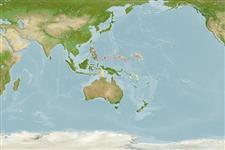>
Gobiiformes (Gobies) >
Gobiidae (Gobies) > Gobiinae
Etymology: nannai: Named after the Sumerian moon god, Sin, who had several names corresponding to its different phases; the name 'Nanna' represented the full moon, in allusion to the moon-like lateral spots on the body.
Eponymy: Professor Cornelius Jan van der Horst (1889–1951) was a Dutch zoologist who moved to South Africa (1928) and became Head of the Zoology Department, Witwatersrand University, Johannesburg. [...] This refers to the Sumerian moon god Sin, who had several different names corresponding to phases of the moon; the name ‘Nanna’ represented the full moon, referring to moon-like lateral spots on this goby. (Ref. 128868), visit book page.
More on authors: Winterbottom, Iwata & Kozawa.
Environment: milieu / Klimaatzone / Diepte / distribution range
Ecologie
marien demersaal; diepte 5 - 20 m (Ref. 90102). Tropical
Western Pacific: Palau and the Philippines.
Grootte / Gewicht / Leeftijd
Maturiteit: Lm ? range ? - ? cm
Max length : 3.3 cm SL mannelijk / geslacht onbekend; (Ref. 53948); 3.0 cm SL (female)
Korte beschrijving
Determinatiesleutels | Morfologie | Morfometrie
Dorsale stekels (totaal) : 7; Dorsale zachte stralen (totaal) : 11; Anale stekels: 1; Anale zachte stralen: 11; Wervels: 26. This species is distinguished by the following characters: shares with Vanderhorstia papillo the elongated 5" (upper lobe) and 9" (lower lobe) branched caudal fin rays; differs from V. papillo in having more lateral scales (41-45 vs. 27); no scales in the predorsal midline (vs. 11); a unique color pattern (off-white background with large yellow spots along the midlateral body vs. such spots absent, and absence of four dark gray brown saddles on body vs. present); adults with both third and fourth dorsal spines elongate; more lower gill rakers on the first arch (16-17 vs. 10); fewer pseudobranch filaments (6-7 vs. 9); a single papilla in row c on the cheek (vs. 4) and row b not interrupted (vs. in two sections) (Ref. 53948).
Body shape (shape guide): elongated; Cross section: compressed.
Based on a photo taken from the Philippines, it is reasonable to assume that it is associated with burrows made and occupied by alphaeid shrimps (albeit no visible evidence of the shrimp in the image), as is the case in all it congeners for which information is available (Ref. 53948). Found in sand-rubble bottoms in 5-20 m (Ref 90102).
Levenscyclus en paargedrag
Maturiteit | Voortplanting | Paaien | Eieren | Fecunditeit | Larven
Winterbottom, R., A. Iwata and T. Kozawa, 2005. Vanderhorstia nannai, a new species of burrow-associated goby from Palau and the Philippines (Pisces: Gobiidae). aqua, J. Ichthyol. Aquat. Biol. 9(3):109-114. (Ref. 53948)
Status op de Rode Lijst van het IUCN (Ref. 130435: Version 2025-1)
Gevaar voor de mens
Harmless
Gebruik door de mens
Tools
Speciale rapporten
Download XML
Internetbronnen
Estimates based on models
Preferred temperature (Ref.
123201): 28.7 - 29.4, mean 29 °C (based on 212 cells).
Fylogenetische diversiteitsindex (Ref.
82804): PD
50 = 0.5000 [Uniqueness, from 0.5 = low to 2.0 = high].
Bayesian length-weight: a=0.00724 (0.00339 - 0.01546), b=3.10 (2.92 - 3.28), in cm total length, based on LWR estimates for this (Sub)family-body shape (Ref.
93245).
Trofisch niveau (Ref.
69278): 3.1 ±0.3 se; based on size and trophs of closest relatives
Weerstandsvermogen (Ref.
120179): Hoog, minimale populatieverdubbelingstijd minder dan 15 maanden (Preliminary K or Fecundity.).
Fishing Vulnerability (Ref.
59153): Low vulnerability (10 of 100).
🛈
